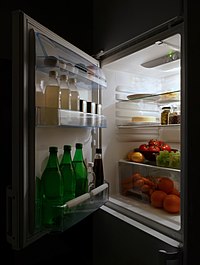
Photo from wikipedia
In the framework of Quantitative Microbiological Risk Assessment, the estimation of the ingested dose of a hazard by the consumer is of paramount importance. This may be calculated by means… Click to show full abstract
In the framework of Quantitative Microbiological Risk Assessment, the estimation of the ingested dose of a hazard by the consumer is of paramount importance. This may be calculated by means of predictive modeling of growth/inactivation of the pathogen studied. For products that spend the majority of their shelf life in the domestic refrigerator, storage temperature will significantly impact the microbial population dynamics. To describe the variability of domestic storage temperatures in Poland, a survey including 77 participants, was carried out in Lodz, Poland. Participants were provided with temperature data loggers, which measured their refrigerator temperature for 24 h in 5-min intervals. The temperature-time profiles were used to calculate the mean working temperature, standard deviation, minimum and maximum values, and the data were statistically analyzed to find the best fitting probability distribution using R programming language. Out of the tested refrigerators, 49.35% had a mean working temperature of over 5 °C and 3.9% exceeded 10 °C. Distribution fitting scenarios were tested for goodness of fit, and the final selected distribution was a truncated normal distribution. This study can prove useful in Monte Carlo simulation analysis for stochastic quantitative food risk assessment in Poland.
Journal Title: International Journal of Environmental Research and Public Health
Year Published: 2023
Link to full text (if available)
Share on Social Media: Sign Up to like & get
recommendations!